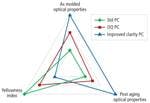This article was published in the November/December 2012 issue of LEDs Magazine.
View the Table of Contents and download the PDF file of the complete November/December 2012 issue, or view the E-zine version in your browser.
+++++
Technological advancements in light-emitting diodes (LEDs), such as higher lumen output and longer life spans, together with their expansion into the huge general lighting market require commensurate advancements in materials used in solid-state-lighting (SSL) products. Polycarbonate (PC) resins in various optical applications for LEDs such as lenses, covers, tubes, pipes, diffusers and reflectors offer a good complement with improved clarity and the ability to withstand high temperatures.
Improved-clarity PC technologies offer potential solutions to all these issues. Although polymethyl methacrylate (PMMA) and, to a lesser extent, glass, have traditionally been chosen for LED optical applications, both materials have drawbacks that these new PC materials avoid. Further, as LEDs continue to evolve and raise the bar on requirements for optical components, the high-performance attributes of PC accommodate new demands – higher temperature ranges, longer exposure to heat and tougher flammability requirements.
The latest PC technology provides a comprehensive value proposition to meet current and future requirements from molders, manufacturers and regulators (Fig. 1). This benefits package includes exceptional mechanical properties and durability, light transmission on par with PMMA, freedom to design and mold configurations and build in specific diffusion levels, and most critically, compliance with safety and sustainability mandates.
These PC resins are engineered with improved monomers and are produced using a technologically advanced process. This process results in high-purity resins that provide significantly improved light transmission as molded and after heat aging, as compared to standard- and optical-grade PCs, as well as other performance enhancements. Improved-clarity resins are helping to drive the growing prominence of PC in the LED market, particularly the general- and automotive-lighting sectors.
Let’s consider some of the major advantages of improved-clarity PCs over traditional acrylics and glass for LED optical components.
PC life span
One of the chief advantages of LEDs is their extended useful life of >30,000 hours (more than 10-15 years). While this long life span means LEDs are more environmentally responsible and cost-effective than previous types of lighting, it raises concerns about the durability of LED lenses, tubes, reflectors and covers. Will these parts last as long as the LED itself without degrading from exposure to heat and ultraviolet (UV) light? Will covers and lenses effectively protect the expensive LED light source from impact and damage, particularly in residential retrofit applications where consumers handle, and sometimes drop, the replacement lights?
Because LEDs are increasingly used for architectural lighting, exterior lighting (e.g., parking lots, street lamps) and automotive applications, weatherability is critical to optimal light transmission and life span. Depending upon their formulation, improved-clarity PC resins can provide UV and weatherability resistance according to UL746C with the necessary F1 rating (Fig. 3). Resistance to UV light, which can cause yellowing and embrittlement of polymers, is a major aspect of outdoor exposure, however, even interior LED fixtures must be able to withstand UV radiation from ambient light and sometimes from the source itself. Improved-clarity PC resins offer enhanced anti-yellowing performance to maintain light transmission and resist becoming brittle so they retain their excellent impact properties.
In outdoor lighting, transparent, weatherable PC resins offer a welcome alternative to both glass and PMMA because they combine high impact performance to protect the solid-state LED from vandalism and other threats, meet stringent UL requirements for weatherability and flame retardancy and optimize forward transmission of light. In contrast, breakable glass does not provide sufficient impact protection, and PMMA does not meet UL94 V0 requirements.
Heat aging, another aspect of LED life span, is becoming even more important as high-brightness LEDs (HB LEDs) with higher lumen outputs place added stress on optical components. Improved-clarity PCs can handle extended exposure to temperatures of 110°C to 130°C, which is a developing trend for HB LEDs, while retaining their mechanical and optical properties.
PC brightness
Some LED applications, such as downlights and spotlights for industrial or commercial spaces, call for maximum brightness. Also, designers and manufacturers are looking for ways to reduce LED costs by optimizing brightness while minimizing power consumption. In these cases, it is vital to take full advantage of every lumen produced by the LED module. In contrast, applications such as residential lighting require a uniform, diffuse light that hides hot spots. Covers, lenses, tubes and reflectors used with LED light sources play a crucial role in striking the right balance between transmission and diffusion.
When diffusion is required, specialized PC resins can provide a broad spectrum of light management to customize performance without compromising forward light transmission (Fig. 4). Different diffusion technologies can provide narrow-angle or wide-angle light scattering, while diffusers plus opacifiers combine translucent scattering with wide-angle light scattering. PC manufacturers such as SABIC may be able to tailor diffusion properties to meet customer requirements. Diffusion-based PC products also provide a system solution that could potentially be more effective and cheaper than a diffuser film that is often used in such applications.
Specialized anti-dust grades of PC can meet requirements for reflectors used in LED downlight applications. These reflectors need to provide diffused light (rather than specular reflection) and retain their reflective properties over the life of the downlight. Anti-dust capability helps to maintain long-term reflectivity performance. At the same time, although the PC grades are highly filled, they retain their excellent mechanical properties. Finally, the design freedom provided by PC facilitates the creation of diverse reflector shapes. In contrast, anti-dust PMMA materials cannot deliver equivalent mechanical performance and do not meet UL94 V0 flame retardancy requirements.
PC heat properties
LEDs generate heat that is not fully dissipated by heat sinks. Therefore, materials used for lenses, reflectors and covers in close proximity to the light source must be thermally stable and flame retardant. Heat generation is increasing due to higher brightness of LEDs that require at least 1W of power or more. Miniaturization to reduce material costs and meet market demands is also contributing to higher temperatures –not only are LEDs positioned closer to other components, but heat sinks are shrinking due to lack of available space and therefore are less able to dissipate heat.
In fact, typical operating temperatures for HB LEDs are already around 80°-90°C, and are expected to go higher by 20°-30°C as more powerful modules and smaller form factors are developed. Specialized PC resins address this trend by providing thermal resistance up to 130°C, which represents an improvement of 20°-30°C over standard PMMA. Above 110°C, PMMA begins to deform. As mentioned earlier, improved-clarity PC grades retain their high light transmission and mechanical properties after extended heat aging, even at elevated temperatures. Some of the LED replacements for higher wattage incandescent bulbs (e.g. 75W or 100W) already require temperature resistance over 120°C.
In addition to compliance with safety standards, these clear, flame-retardant PCs use technology that supports environmental directives. By avoiding bromines, chlorines and phosphates, these materials comply with eco labels and regulations such as the European Union’s Restriction of Hazardous Substances (RoHS) directive.
PC design options with LEDs
The general lighting industry is fragmented and complex. LEDs are adding complexities. The diversity of the market is creating the need for versatile materials that combine high performance with attractive aesthetics and innovative designs.
LED designs are already more diverse than those used for incandescent or fluorescent lighting. To address this trend, plastics such as PC offer a choice of processing methods (injection and blow molding, and extrusion), molded-in color and the ability to create complex shapes, including part integration. Glass presents significant design limitations in these areas.
When comparing plastic types, PC surpasses PMMA in the breadth of its design window. In particular, PC enables sharp corners and notches that can further accentuate PMMA’s weakness in impact strength. When extruding large diffuser sheets used for wall and ceiling LED applications, PC maintains its impact and rigidity better than PMMA, which tends to sag. Similarly, PC’s dimensional stability, as well as strength and toughness, enable thin-wall molding (ranging from 0.5 mm to 1.0 mm) for cost savings and weight reduction as well as improved light efficiency.
One interesting area for LED design innovation is automotive head lamps. LEDs are being used for special lighting enhancements including so called angel eyes or accent lights providing a halo effect and in strips used for daytime running lights or fog lamps, which have been pioneered by Audi and Mercedes-Benz. Versatile PC resins can contribute high light transmission combined with UV resistance, impact resistance and high heat tolerance to these distinctive designs.
Specialty PC resins have also been engineered with high reflectivity performance. These materials can be used in head lamp reflectors to maximize the luminance of LED modules without the need for secondary coatings or plating. They also offer the opportunity to integrate the reflector into the LED module.
PC is an excellent choice in architectural lighting as well as automotive lighting for light pipes or tubes, which are used to move light from its source to its destination by channeling it over a few millimeters or up to 100 meters. Light pipes provide design flexibility and eliminate components and assembly steps. PC provides the right balance of optical properties (transmission and refractive index), durability and process ability (extrusion or profile) for these applications – particularly long, thin pipes.
PC is becoming a preferred material for tubes, covers, lenses and reflectors in LED lighting designs. Specialized PC grades have been engineered with a range of desirable performance attributes – from thin-wall capability to exceptional heat aging performance to sustainable flame-retardant systems – which build upon the material’s classic impact resistance, toughness and clarity. As LED technology races ahead, new applications are developed, new markets are penetrated and regulations evolve, PC resins provide the variety, performance and versatility to meet these new challenges.









